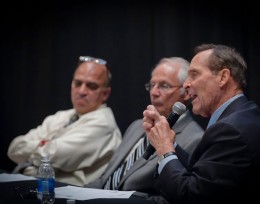
Chancellor Jim Petro speaks during a commercialization session at Wright State. To his right are Wright State President David R. Hopkins and Regent Vinny Gupta, chair of the Ohio Commercialization Task Force.
A brainstorming session at Wright State was Ohio’s latest effort to create jobs by getting more university research and inventions onto store shelves.
A report by the Technology Transfer & Commercialization Task Force was presented at the Student Union on Aug. 28, attracting about 100 university officials, business leaders and lawmakers, including state Sen. Chris Widener.
Regent Vinny Gupta, chair of the task force, said $17 billion in research is conducted in Ohio, but only a tiny fraction of it is commercialized.
“We’ve not done it well in the past,” Chancellor Jim Petro said of efforts to commercialize university research. “We must do it much better in the future.”
Wright State President David R. Hopkins, who served on the task force, said the university has already stepped up its commercialization efforts.
For example, Wright State soon plans to invest in a new company started by a graduate. And to accelerate the commercialization of university research, Wright State is embedding a faculty member into Mound Laser & Photonics Center, Inc., which uses lasers to fashion miniature devices for the defense and medical device industries.
“We are determined to be a partner in growing jobs and business in this region so our students, when they graduate, have places to stay in Ohio,” Hopkins said.
Goals of the task force included identifying barriers to commercialization and developing strategies to overcome them.
Recommendations include encouraging faculty members to conduct research and giving them incentives to commercialize it; making it easier for businesses to collaborate with universities; developing strong regional partnerships; increasing the number of STEM students; creating more internship opportunities; and working to help create new start-up businesses.
Questions and suggestions from the audience revolved around how to incentivize university researchers to actually come up with inventions; how to create guidelines for the sharing of university equipment with businesses; how to get business students involved with commercialization efforts; how to identify market opportunities for inventions; and how to get community colleges involved in filling workforce needs.

 Milling around
Milling around  Wright State recognizes Nursing Professor Kim Ringo for advancing international student success
Wright State recognizes Nursing Professor Kim Ringo for advancing international student success  Wright State honors graduating students for distinguished doctoral dissertations
Wright State honors graduating students for distinguished doctoral dissertations  Top 10 Newsroom videos of 2025
Top 10 Newsroom videos of 2025  Museum-quality replica of historic Hawthorn Hill donated to Wright State
Museum-quality replica of historic Hawthorn Hill donated to Wright State 